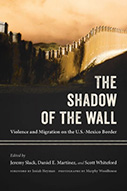The Shadow Of The Wall: Violence And Migration On The U.S. Mexico Border

Editors: Jeremy Slack, Daniel E. Martinez, and Scott Whiteford
Publisher: Tucson: University of Arizona Press. 2018. 280p.
Reviewer: Andrew Roesch-Knapp | September 2019
The Shadow of the Wall: Violence and Migration on the U.S.-Mexico Border is an interdisciplinary anthology detailing the myriad social consequences of contemporary border enforcement. The volume is centered around the major findings of the Migrant Border Crossing Study (MBCS), and is a searing academic testament to the multifaceted violence of U.S. immigration policy and the violence of deportation. Because of the scholarly writing, this book is well-suited for scholars and social policy makers interested in an anthology rich in empirical data on borders and the criminalization of immigration.
The research contained within this volume was conducted during two waves of data collection, and incorporates both qualitative and quantitative data. Ultimately, more than 1,600 post-deportation surveys were conducted. The first wave was carried out at an overnight migrant shelter in Nogales, Sonora. The second wave significantly expanded the scope of the project to include surveys, interviews, and ethnographic observations in eleven overnight migrant shelters and border entry points across six locations in Mexico.
The first of three sections in the book introduces some theoretical frameworks for violence, the MBCS research methodology, and a chapter detailing the often-conflicting responsibilities that researchers have for their own teams’ safety, the safety of their research subjects, and the obligation to conduct ethical academic research. The authors explain that this methodological reflexivity was brought to the fore when a civilian was killed across the street from a migrant shelter, as they sat conducting interviews one evening in Nogales, Sonora in 2008. After the killing, the team debated whether it was responsible to continue the project and, ultimately, data collection was suspended from October 2008-March 2009, after which point the project resumed. Three members of the research team explain their individual perspectives on this particular decision. They each discuss the multiple and sometimes conflicting methodological, ethical, and safety concerns researchers must navigate – especially amidst unpredictable acts of violence – and the frankness of their discussion here is well-received.
The second section of the book examines the dramatic rise in the criminalization of immigration over the last several decades. Building on a considerable body of academic literature, the authors advance a compelling case for broadening the theoretical and empirical lens by which immigration scholars study the criminalization of migrants. In this framework, the authors move away from a central focus on the Clinton-era border enforcement strategy of “prevention through deterrence,” and incorporate other policies. Specifically, the authors suggest that the implementation of the Consequence Delivery System (CDS) in 2011 under former President Obama provided the United States Border Patrol (USBP) with multiple new resources. Two of the CDS programs discussed are Operation Streamline, which prosecutes migrants en masse, and the Alien Transfer and Exit Program (ATEP), which apprehends and laterally deports migrants to other parts of the border.
Ultimately, the MBCS study finds that despite these and other policies, the one factor that most powerfully determined whether a person was going to try to cross the border again was having family members in the United States. Fifty-five percent of all survey respondents stated that they intended to return to the U.S. in the future. An additional thirty percent stated that their current home is the United States, and eighty-eight percent of these persons said they would cross the border again to get back into the United States. What the evidence shows is that despite the myriad risks and potential punishments associated with crossing the border clandestinely, a majority remain undeterred. The deterrence against illegal immigration sought by arrest, criminal conviction, incarceration, and deportation is not apparent. Instead, migrants have what the authors refer to as “place attachment,” and are in a precarious-enough position to be willing to risk their lives by crossing the border again.
The latter part of the book shifts focus slightly to detail the unintended consequences of immigration and border enforcement. According to the authors, the scope of problems associated with deportation result not only directly from US immigration practices, but in addition, for example, immigration policies may drive economically-vulnerable migrants to the margins. These margins – both geographically and legally-speaking – then provide the impetus for migrants to seek illegal entry into the United States, and are thus counterproductive to the goal of deterrence. In addition, once excluded by the formal legal immigration procedures, migrants often attempt to clandestinely navigate the treacherous terrain of the desert, and consequently are in closer proximity to extra-legal actors such as Mexican drug traffickers and kidnappers who may prey on them. The authors describe these drug traffickers and coyotes, and advance an empirically-grounded, theoretically robust understanding of how these illicit networks operate at the edges of the state.
One of the unique attributes of this book is the inclusion of some thirteen color photographs. The subject matter of the photographs revolves around immigration and deportation, and the images include subjects such as the border wall jutting out into the Pacific west of Tijuana, deportees exiting a government bus having been repatriated back to Mexico, the location along the border wall where a young Mexican boy was killed by a U.S. Border Patrol agent, and the nearby altar that was made to commemorate the boy.
Viewing these photographs, the reader cannot help but be drawn to how they render the invisible visible. After all, in important ways, the geo-political violence and suffering along the border may be upheld, it least in part, by its invisibility. While photographs certainly do not replace methodologically-rigorous sociological research, the inclusion of photographs in social science volumes may enable some readers to understand the subject matter in a new way altogether. This is particularly true given the violence of illegal immigration and deportation. This is a violence that is inflicted not solely on individuals or even families, but on entire communities and geographic regions. In this way, it is eerily similar to the violence, death, and suffering caused by the U.S. prison system. Using this volume as a model, it may be beneficial for scholars of both immigration and incarceration to ask how documentary photography may communicate research findings to a wider audience.
Overall, what this book does most successfully is to show the very complexity of the problem itself. Deportation is not a singular issue with a singular solution, but rather a practice amidst a complex assemblage of immigration practices that inflict violence – both directly and indirectly – on vulnerable populations of color. What we get is a deeply nuanced portrait of the migrant experience and how deportation is a multifaceted form of violence. There is the sophisticated and intertwined relationship among the coyotes who guide individuals across the border into the United States, the human smugglers, the drug cartels, and the kidnappers. There is also the presence of immigration enforcement agents in the borderlands, the physicality of the high barbed-wire border wall, and the extreme and deadly aspects of the desert. And, there is also the labyrinthine U.S. carceral system. All of these elements are integral to America’s chimerical pursuit of border security, and this volume methodically shows how they all almost invariably lead to migrants’ suffering in one form or another.
Andrew Roesch-Knapp, Doctoral student, Department of Criminology, Law and Society, The University of California at Irvine


